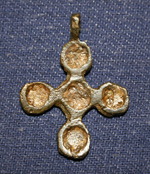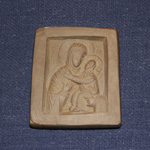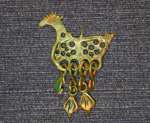Archaeology of Belozersk district
On April 12, 2008 a new exhibition “Antiquities of Belozersk district. History of the region based on the materials of archeological excavations” is being opened on the lowest floor of the Church of the Presentation of the Virgin in the Temple with the refectory. It is the first full exhibition representing archaeology of the Belozersk district in the Vologda Region. Materials of the monastery archeology are displayed for the first time in our region. More than 4000 archeological objects dating back to different chronological periods are represented there: from the Mesolithic period (9000 B.C.) till the late Middle Ages. The Medieval period is fully represented, and that makes this exhibition one of the largest in the North-West of Russia. Among the exhibits there are unique works of ancient art, unique not only in the collection of this museum, but in the archaeological collections of other Russian museums as well.
 The basis for the extensive archaeological collection is formed by the materials received by the museum as a result of the expeditions carried out in 1980-1990. The main part of the exhibited materials dating back to the Middle Ages represents all types of archaeological sites: rural settlements, fortified settlements, cemeteries. The most interesting finds come from the often mentioned in the chronicles town Belozersk, multi-layer sites of the archaeological complex Minino, Nephedyevo cemeteries and Kemsky necropolis. Materials of the archaeological digs carried out on the territory of the Kirillo-Belozersky monastery have provided a basis for the latest archaeological collection of the museum.
The basis for the extensive archaeological collection is formed by the materials received by the museum as a result of the expeditions carried out in 1980-1990. The main part of the exhibited materials dating back to the Middle Ages represents all types of archaeological sites: rural settlements, fortified settlements, cemeteries. The most interesting finds come from the often mentioned in the chronicles town Belozersk, multi-layer sites of the archaeological complex Minino, Nephedyevo cemeteries and Kemsky necropolis. Materials of the archaeological digs carried out on the territory of the Kirillo-Belozersky monastery have provided a basis for the latest archaeological collection of the museum.
The exhibition “Antiquities of Belozersk” is placed in four halls. In the first exhibition hall there is the reconstruction of the grave from the Mesolithic period, ceramics of the late Stone Age and a map of the Belozersk district where about 500 archaeological sites are marked. Materials of the most ancient settlements in the district dating back to the Stone Age, Bronze Age and early Iron Age are represented in the next hall. Exhibits, maps, plans, reconstructions illustrate that period when the region was inhabited by the Finno-Ugrian and Slavonic tribes in the 10th-13th centuries.
 Considerable part of this exhibition hall is dedicated to the history of the ancient town Belozersk. Archaeological materials testify the development of carving, weaving and working of ferrous and non-ferrous metals in the town and such occupations of the inhabitants as farming, hunting and fishing. Numerous finds of trading seals and coins bear witness to the development of trade. Zoomorphic decorations prevail in the jewelry. A special place in the female costume of the town was occupied by glass bracelets, which could be hardly found in the village settlements. Gold wares show wealth of the inhabitants. Finds of an iron scriber and book fasteners tell us about their literacy. The town Beloozero was the centre of christianization of this district. Crosses and icons were made of various materials, including stone, and were also brought from other regions. Among the finds there are real works of art of local craftsmen. For example, an unfinished stone icon with the image of St. Gleb, patron of the Belozersk prince Gleb Vasilkovich (13th century) is on display in this exhibition. Rural settlements of the district, contemporaries of the ancient town Belozersk, are represented by the materials from the most extensively studied and the unique in scientific respect archaeological complex Minino.
Considerable part of this exhibition hall is dedicated to the history of the ancient town Belozersk. Archaeological materials testify the development of carving, weaving and working of ferrous and non-ferrous metals in the town and such occupations of the inhabitants as farming, hunting and fishing. Numerous finds of trading seals and coins bear witness to the development of trade. Zoomorphic decorations prevail in the jewelry. A special place in the female costume of the town was occupied by glass bracelets, which could be hardly found in the village settlements. Gold wares show wealth of the inhabitants. Finds of an iron scriber and book fasteners tell us about their literacy. The town Beloozero was the centre of christianization of this district. Crosses and icons were made of various materials, including stone, and were also brought from other regions. Among the finds there are real works of art of local craftsmen. For example, an unfinished stone icon with the image of St. Gleb, patron of the Belozersk prince Gleb Vasilkovich (13th century) is on display in this exhibition. Rural settlements of the district, contemporaries of the ancient town Belozersk, are represented by the materials from the most extensively studied and the unique in scientific respect archaeological complex Minino.
Grave monuments are exhibited in the third hall. They substantially expand rare written evidence and in most cases they are unique sources allowing scientists to make conclusions about ethnic origins of the buried persons, their way of life, material culture, traditions and belief, and also about food and paleoecological conditions.
 Collection exhibited in the fourth hall gives an opportunity to shed light on some sides of the monastery life which can’t be restored with the help of other sources. Investigations of the forgery, armoury, malt-house, ice-houses and necropolises of the Kirillo-Belosersky monastery replenish museum funds with the details of the architectural decor of the first stone constructions and objects produced there. Of special importance are the finds discovered during the study of cultural stratifications of the 16th century with the so-called moist layer which preserves objects of organic materials: wood, leather, fabrics, giving an idea of some aspects of the everyday monastery life.
Collection exhibited in the fourth hall gives an opportunity to shed light on some sides of the monastery life which can’t be restored with the help of other sources. Investigations of the forgery, armoury, malt-house, ice-houses and necropolises of the Kirillo-Belosersky monastery replenish museum funds with the details of the architectural decor of the first stone constructions and objects produced there. Of special importance are the finds discovered during the study of cultural stratifications of the 16th century with the so-called moist layer which preserves objects of organic materials: wood, leather, fabrics, giving an idea of some aspects of the everyday monastery life.
The archaeological collection of the Kirillo-Belozersky museum was regularly enlarged owning to the expeditions organized under the direction of A.Y. Bryusov, P.A. Sukhov, L.A. Golubeva, S.V. Oshibkina. The basis of the fund is formed by the materials of the Onezhsko-Sukhonskaya expedition led by N.A. Makarov. In the course of the expeditions they gathered an enormous collection of the 11th-12th centuries objects including vast numismatic material, jewelry and details of the costume, household objects and arms.
Every year since 1994 archaeological investigations of the territory of the Kirillo-Belozersky monastery are conducted by a group of the Vologda scientific and production centre “Antiquities of the North” headed by the archaeologist A.V. Suvorov.






